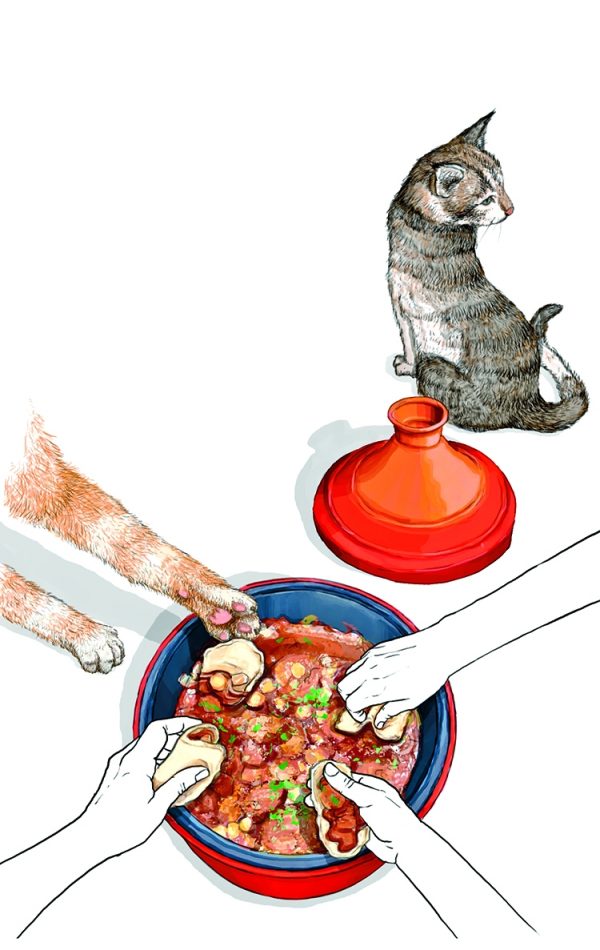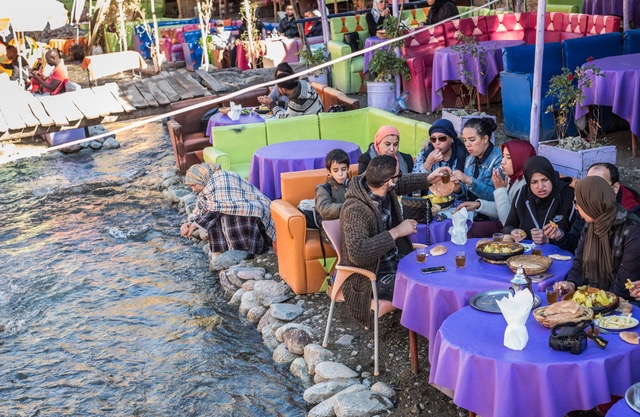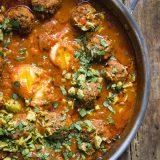
In Morocco, tagines are a communal dish, often prepared and eaten with others at outdoor shops. They also come with their own unspoken etiquette, some of which can befuddle an inexperienced visitor.
■ Lose the Utensils
No, they didn’t forget the silverware. A thick flatbread called khobz is the only utensil you’ll get. Stacks of the round, yeasted loaves come to the table with tagine. Brace for messy fingers, tear off a corner of khobz and use it to grab hunks of meat and vegetables, mopping up the rich sauce.
■ Stick to Your Quadrant
Don’t go grabbing that tasty-looking morsel of chicken on the other side of the platter. Though tagines are served and consumed family-style from the center of the table, diners are expected to eat only from the section directly in front of them. It is bad form to reach in front of other people.
■ Feed the Cats
In Morocco, you never eat alone. Stray cats are legion, and many congregate around tagine shops. It is customary to save the final morsels of a tagine for the cats at your feet. And they know it.
Eating tagine in the Ourika Valley—a speck of a community an hour south of Marrakech that seems to exist for no other purpose than to serve Morocco’s signature dish—one must decide: Eat with the fish or eat with the cats.
Tucked tight in a narrow cleft between peaks of the Atlas Mountains, the area itself is split by the gushing Ourika River, a shallow burble whose banks are clustered with dozens of restaurants so informal that eateries and clay-walled homes blur.
Fronting the open-air restaurants are long, trough-like charcoal grills, each topped with dozens of tagines, the conical clay pots in which the dish of the same name is prepared. Rich, meaty smoke swirls out from underneath as cooks toss beefy chunks of fat onto the red coals to draw customers from the crowded single street that runs through town.
Along and even in the river, plastic tables and chairs are poised precariously on river stones, water rushing around them and the feet of the diners seated at them. The alternative—drier—tables farther ashore are inhabited by Morocco’s omnipresent stray cats, weaving between the legs of table, chair and human, waiting for shared last bites of tagine, as custom dictates.
Hoping to stay dry, I opt to eat with the cats, picking a wobbly table monitored by a dusty calico and served by Café Restaurant Imlil. For 165 Moroccan dirhams (about $18), two massive round platters arrive—beef with prunes, raisins and caramelized onions; lamb with potatoes and carrots in a buttery sauce—plus a basket heaped high with robust flatbreads to serve as both starch and utensil.
The meats are fall-apart tender, rich but not heavy. The thick chunks of vegetables are soft without being mushy. The flavors present a puzzlingly good tug between sweet and savory, all of it tied together by a floral undercurrent of turmeric and saffron. The calico and I agree: The meal is delicious, no doubt enhanced by the epic scenery that soars above us on either side.

I’d come to Morocco to learn about tagine, a desert-friendly dish that uses the pyramid-like lid of the shallow pot to condense steam, allowing food to be stewed with little liquid. Over six days, I ate numerous tagines, many of them iterations of the usual suspects—chicken or lamb or beef with preserved lemon. All were delicious, but I was searching for something ... different.
My journey began in the souk, Marrakech’s maze-like market, where cheap pottery competes with swindling teenagers for the attention of tourists. Not surprisingly, the tagines here were mostly disappointing—soppy, flavorless affairs cooked streetside more for show than quality. Of course, explained Soufiane Najah, my photographer: The best tagines are homemade.
Which is how the next day I found myself four hours north in Casablanca, a bustling, modern oceanfront city entirely unlike Hollywood’s fabrications. It’s also home to Najah’s mother, Saadia Lajaj, who welcomed me into her apartment—the intricate carved plaster ceiling of which transfixed me—for a lesson in tagines.
The best are cooked over charcoal, Lajaj explained as she prepared lham bel mechmach, a lamb and onion tagine that is an amalgam of recipes learned from her mother and friends at the bank where she works. But for most home cooks, coals are no longer practical, so she cooks tagine on the stovetop, often in a pressure cooker to speed things along.
I knew moisture was key to tagine—less of it means flavors become more concentrated. But that’s just the start, Lajaj explained. Unlike many North African cuisines, which have pronounced spice, Moroccan foods—and tagines especially—aim for a balance of savory and sweet, the latter often provided by dried fruits. Particularly robust savory ingredients—in this case lamb, ginger and garlic—require more assertive sweetness. Hence the dried apricots and pineapple that Lajaj added.
The result: an intensely flavorful, thick sauce potent with seasonings mellowed by fruity sweetness. The lamb was so tender that it shredded at the touch into thick chunks that nestled into flatbread. But even with the pressure cooker, it was a lengthy affair, taking several hours to prepare. My search continued.
Which is how I found Al Fassia, an upscale restaurant back in Marrakech with velvet-red walls, punched-tin lights and a reputation for tagine. I ordered one of each: chicken and lemon, a vegetarian version with potatoes and zucchini, and an intriguing outlier—meatball. Robustly beefy, wonderfully soft meatballs were poached in a gently sweet tomato sauce, then topped with lightly poached eggs.
From the first bite, the meatballs were the obvious winner—a familiar form with unexpected flavors. The sauce was sweet but not saccharine, the sweetness coming not from sugary dried fruit but from cinnamon and tomatoes, a wonderful balance to the cumin-spiked beef. Meanwhile, the gentle cooking kept the meatballs tender and moist. The egg yolks spilled into the sauce and coated the meat, adding richness. This was the tagine I’d been searching for.
Bringing this recipe back to Milk Street was mostly a matter of crockery. Or lack thereof. Few Americans own tagines. We considered a saucepan or Dutch oven, but both lack the broader surface area needed to quickly create a rich, concentrated sauce. A large skillet was best. In it, we sautéed onion with garlic, cinnamon, cumin and coriander to create a double-duty base: Some went into the meatballs, the rest into the tomato sauce. While Italian meatballs are typically browned, that’s a step less common in tagines. We preferred the clean flavor that came from simply simmering them in the sauce.
Our tagine was still a bit unbalanced; it missed the briny flavor most Moroccan tagines get from preserved lemons. But they remain somewhat difficult to find in the U.S., so we recreated that bright flavor by mixing in a blend of chopped green olives and lemon zest at the end of cooking.
Related Recipes
May-June 2018

Sign up to receive texts
Successfully signed up to receive texts!
We'll only send our very best offers - Like a $15 store credit to start.
By entering your phone number and submitting this form, you consent to receive marketing text messages (such as promotion codes and cart reminders) from Christopher Kimball's Milk Street at the number provided, including messages sent by autodialer. Consent is not a condition of any purchase. Message and data rates may apply. Message frequency varies. You can unsubscribe at any time by replying STOP or clicking the unsubscribe link (where available) in one of our messages. View our Privacy Policy and Terms of Service.



